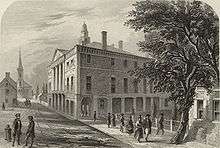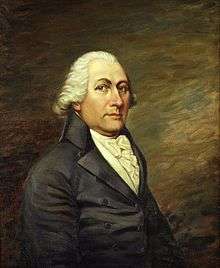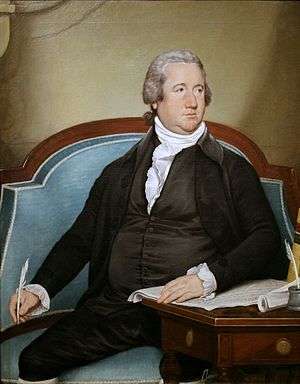1st United States Congress
The 1st United States Congress, consisting of the United States Senate and the United States House of Representatives, met from March 4, 1789, to March 4, 1791, during the first two years of George Washington's presidency, first at Federal Hall in New York City and later at Congress Hall in Philadelphia. With the initial meeting of the First Congress, the United States federal government officially began operations under the new (and current) frame of government established by the 1787 Constitution. The apportionment of seats in the House of Representatives was based on the provisions of Article I, Section 2, Clause 3 of the Constitution. Both chambers had a Pro-Administration majority. Twelve articles of amendment to the Constitution were passed by this Congress and sent to the states for ratification; the ten ratified as additions to the Constitution on December 15, 1791, are collectively known as the Bill of Rights.
| 1st United States Congress | |
|---|---|
Congress of the Confederation ← → 2nd | |
 Federal Hall, site of the first two sessions of this Congress (1789) | |
| March 4, 1789 – March 4, 1791 | |
| Senate President | John Adams (P) |
| Senate President pro tem | John Langdon (P) |
| House Speaker | Frederick Muhlenberg (P) |
| Members | 22–26 senators 59–65 members of the House |
| Senate Majority | Pro-Administration |
| House Majority | Pro-Administration |
| Sessions | |
| 1st: March 4, 1789 – September 29, 1789 2nd: January 4, 1790 – August 12, 1790 3rd: December 6, 1790 – March 3, 1791 | |
Major events

- April 1, 1789: House of Representatives first achieved a quorum and elected its officers.
- April 6, 1789: Senate first achieved a quorum and elected its officers.
- April 6, 1789: The House and Senate, meeting in joint session, counted the Electoral College ballots, then certified that George Washington had been unanimously elected President of the United States and John Adams (having received 34 of 69 votes) was elected as Vice President.[1]
- April 21, 1789: John Adams was inaugurated as the nation's first Vice President.[2][3]
- April 30, 1789: George Washington was inaugurated as the nation's first president at Federal Hall in New York City.
- January 8, 1790: President Washington gave the first State of the Union Address
- June 20, 1790: Compromise of 1790: James Madison agreed to not be "strenuous" in opposition to the assumption of state debts by the federal government; Alexander Hamilton agreed to support a national capital site in the South.
Major legislation
| Wikisource has original text related to this article: |
| Wikisource has original text related to this article: |
Session 1
Held March 4, 1789, through September 29, 1789, at Federal Hall in New York City
- June 1, 1789: An act to regulate the time and manner of administering certain oaths, ch. 1, 1 Stat. 23
- July 4, 1789: Tariff of 1789, ch. 2, 1 Stat. 24
- July 27, 1789: United States Department of State was established, originally named the Department of Foreign Affairs, ch. 4, 1 Stat. 28.
- July 31, 1789: Regulation of the Collection of Duties on Tonnage and Merchandise, ch.5, 1 Stat. 29, which established the United States Customs Service and its ports of entry.
- August 7, 1789: Department of War was established, ch. 7, 1 Stat. 49.
- September 2, 1789: United States Department of the Treasury was established, ch. 12, 1 Stat. 65
- September 24, 1789: Judiciary Act of 1789, ch. 20, 1 Stat. 73, which established the federal judiciary and the office of Attorney General
Session 2
Held January 4, 1790, through August 12, 1790, at Federal Hall in New York City
- March 1, 1790: Made provisions for the first Census, ch. 2, 1 Stat. 101
- March 26, 1790: Naturalization Act of 1790, ch. 3, 1 Stat. 103
- April 10, 1790: Patent Act of 1790, ch. 7, 1 Stat. 109
- April 30, 1790: Crimes Act of 1790, ch. 9, 1 Stat. 112
- May 31, 1790: Copyright Act of 1790, ch. 15, 1 Stat. 124
- July 16, 1790: Residence Act, ch. 28, 1 Stat. 130, established Washington, D.C. as the seat of government of the United States.
- July 22, 1790: Indian Intercourse Act of 1790, ch. 33, 1 Stat. 137, regulated commerce with the Indian tribes.
- August 4, 1790: Funding Act of 1790, ch. 34, 1 Stat. 138, authorized the "full assumption" of state debts by the federal government.
- August 4, 1790: Collection of Duties Act, ch.35, 1 Stat. 145, among its provisions is Sec. 62, 1 Stat. 175, authorizing establishment of the Revenue-Marine, since 1915 the United States Coast Guard.
- August 10, 1790: Tariff of 1790, ch. 39, 1 Stat. 180
Session 3
Held December 6, 1790, through March 3, 1791, at Congress Hall in Philadelphia
- February 18, 1791: Admission of Vermont postdated to March 4, ch. 10, 1 Stat. 191
- February 25, 1791: First Bank of the United States, ch. 10, 1 Stat. 191
- March 3, 1791: Tariff of 1791, ch. 15, 1 Stat. 199, which triggered the Whiskey Rebellion
Constitutional amendments
- September 25, 1789: Approved 12 amendments to the United States Constitution establishing specific guarantees of personal freedoms and rights, clear limitations on government power, and submitted them to the state legislatures for ratification. 1 Stat. 97:
- Article one has not been ratified and is still pending before the states.
- Article two was much later ratified on May 7, 1992, as the Twenty-seventh Amendment.
- Articles three through twelve, known as the "Bill of Rights," were later ratified on December 15, 1791.
States ratifying Constitution
- November 21, 1789: North Carolina became the 12th state to ratify the U.S. Constitution and thereby joined the Union.
- May 29, 1790: Rhode Island became the 13th state to ratify the U.S. Constitution and thereby joined the Union.
Territories organized
Party summary
There were no political parties in this Congress. Members are informally grouped into factions of similar interest, based on an analysis of their voting record.[4]
Details on changes are shown below in the "Changes in membership" section.
Senate
During this congress, two Senate seats were added for North Carolina and Rhode Island when each ratified the Constitution.
| Faction (shading shows control) |
Total | Vacant | ||
|---|---|---|---|---|
| Anti- Administration (A) |
Pro- Administration (P) | |||
| End of previous congress | 0 | 0 | 0 | 0 |
| Begin | 7 | 13 | 20 | 2 |
| End | 8 | 18 | 26 | 0 |
| Final voting share | 30.8% | 69.2% | ||
| Beginning of next congress | 9 | 16 | 25 | 1 |
House of Representatives
During this congress, five House seats were added for North Carolina and one House seat was added for Rhode Island when they ratified the Constitution.
| Faction (shading shows control) |
Total | Vacant | ||
|---|---|---|---|---|
| Anti- Administration (A) |
Pro- Administration (P) | |||
| End of previous congress | 0 | 0 | 0 | 0 |
| Begin | 23 | 31 | 54 | 5 |
| End | 28 | 36 | 64 | 1 |
| Final voting share | 43.8% | 56.3% | ||
| Beginning of next congress | 29 | 39 | 68 | 1 |
Leadership
Senate
- President: John Adams (P)
- President pro tempore: John Langdon (P)
House of Representatives
Members
This list is arranged by chamber, then by state. Senators are listed by class, and Representatives are listed by district.
Senate
Senators were elected by the state legislatures every two years, with one-third beginning new six-year terms with each Congress. Preceding the names in the list below are Senate class numbers, which indicate the cycle of their election. In this Congress, all Senators were newly elected, and Class 1 meant their term ended with this Congress, requiring re-election in 1790; Class 2 meant their term ended with the next Congress, requiring re-election in 1792; and Class 3 meant their term lasted through the next two Congresses, requiring re-election in 1794.
Connecticut
Delaware
Georgia
Maryland
Massachusetts
New Hampshire
New Jersey
|
New York
North Carolina
Pennsylvania
Rhode Island
South Carolina
Virginia
|
.jpg) Senate President John Adams  Senate President pro tempore John Langdon
|
House of Representatives
The names of members of the House of Representatives are listed by their districts.
ConnecticutAll representatives were elected statewide on a general ticket.
Delaware
Georgia
Maryland
Massachusetts
New HampshireAll representatives were elected statewide on a general ticket.
New JerseyAll representatives were elected statewide on a general ticket.
|
New York
North Carolina
PennsylvaniaAll representatives were elected statewide on a general ticket.
Rhode Island
South Carolina
Virginia
|
 Speaker of the House Frederick Muhlenberg of Pennsylvania
|
Changes in membership
There were no political parties in this Congress. Members are informally grouped into factions of similar interest, based on an analysis of their voting record.[4]
New York, North Carolina, and Rhode Island, were the last states to ratify the U.S. Constitution, and because of their late ratification, were unable to send full representation at the beginning of this Congress. Six Senators and nine Representatives were subsequently seated from these states during the sessions as noted.
Senate
There was 1 resignation, 1 death, 1 replacement of a temporary appointee, and 6 new seats. The Anti-Administration Senators picked up 1 new seat and the Pro-Administration Senators picked up 5 new seats.
| State (class) |
Vacator | Reason for change | Successor | Date of successor's formal installation[lower-alpha 1] |
|---|---|---|---|---|
| New York (3) | New seats | State legislature failed to choose Senator until after Congress began. | Rufus King (P) | July 25, 1789 |
| New York (1) | Philip John Schuyler (P) | July 27, 1789 | ||
| North Carolina (3) | North Carolina ratified the constitution on November 21, 1789. | Benjamin Hawkins (P) | Elected November 27, 1789 | |
| North Carolina (2) | Samuel Johnston (P) | |||
| Virginia (1) |
William Grayson (A) | Died March 12, 1790. | John Walker (P) | Appointed March 31, 1790 |
| Rhode Island (1) | New seats | Rhode Island ratified the constitution on May 29, 1790. | Theodore Foster (P) | Elected June 7, 1790 |
| Rhode Island (2) | Joseph Stanton, Jr. (A) | |||
| Virginia (1) |
John Walker (P) | James Monroe was elected to the seat of Senator William Grayson. | James Monroe (A) | Elected November 9, 1790 |
| New Jersey (2) | William Paterson (P) | Resigned November 13, 1790, having been elected Governor of New Jersey. |
Philemon Dickinson (P) | Elected November 23, 1790 |
House of Representatives
There was 2 resignations, 1 death, and 6 new seats. Anti-Administration members picked up 3 seats and Pro-Administration members picked up 2 seats.
| District | Vacator | Reason for change | Successor | Date of successor's formal installation[lower-alpha 1] |
|---|---|---|---|---|
| New Hampshire at-large | Benjamin West (P) | Member-elect declined to serve and a new member was elected in the first congressional special election. | Abiel Foster (P) | June 23, 1789 |
| North Carolina 1 | New seats | North Carolina ratified the constitution November 21, 1789. | John Baptista Ashe (A) | March 24, 1790 |
| North Carolina 2 | Hugh Williamson (A) | March 19, 1790 | ||
| North Carolina 3 | Timothy Bloodworth (A) | April 6, 1790 | ||
| North Carolina 4 | John Steele (P) | April 19, 1790 | ||
| North Carolina 5 | John Sevier (P) | June 16, 1790 | ||
| Rhode Island at-large | New seat | Rhode Island ratified the constitution May 29, 1790. | Benjamin Bourne (P) | December 17, 1790 |
| Virginia 9 | Theodorick Bland (A) | Died June 1, 1790. | William B. Giles (A) | December 7, 1790 |
| Massachusetts 5 | George Partridge (P) | Resigned August 14, 1790. | Remained vacant until next Congress | |
Committees
Lists of committees and their party leaders.
Senate
House of Representatives
- Elections (Chairman: N/A)
- Rules (Select)
- Ways and Means (Chairman: Thomas Fitzsimons)
- Whole
Joint committees
- Enrolled Bills (Chairman: Paine Wingate)
Employees
Senate
- Secretary: Samuel A. Otis, elected April 8, 1789
- Doorkeeper: James Mathers, elected April 7, 1789
- Chaplain:
- Samuel Provoost (Episcopalian), elected April 25, 1789
- William White (Episcopalian), elected December 9, 1790
House of Representatives
- Clerk: John J. Beckley
- Sergeant at Arms: Joseph Wheaton, elected May 12, 1789
- Doorkeeper: Gifford Dalley
- Chaplain:
- William Linn (Presbyterian), elected May 1, 1789
- Samuel Blair (Presbyterian), elected December 10, 1790
- Reading Clerks: John Beckley.[5]
See also
- 1788–89 United States elections (elections leading to this Congress)
- 1788–89 United States presidential election
- 1788 and 1789 United States Senate elections
- United States House of Representatives elections, 1788 and 1789
- 1790 United States elections (elections during this Congress, leading to the next Congress)
Notes
- This is the date the member was seated or an oath administered, not necessarily the same date her/his service began.
References
- "Journal of the First Session of the Senate of The United States of America, Begun and Held at the City of New York, March 4, 1789, And In The Thirteenth Year of the Independence of the Said States". Senate Journal. Gales & Seaton. 1820.
- Unger, Harlow Giles (September 4, 2012). John Quincy Adams. Da Capo Press. pp. 71. ISBN 9780306821301.
john adams new york city vice president inauguration April 20.
- "Vice Presidential Inaugurations". Washington, D.C.: Architect of the Capitol. Archived from the original on July 31, 2017. Retrieved July 15, 2017.
- Martis, Kenneth C. The Historical Atlas of Political Parties in the United States Congress.
- "American Memory: Remaining Collections". memory.loc.gov. Retrieved February 13, 2018.
Further reading
- Bickford, Charlene Bangs, and Kenneth R. Bowling. Birth of the nation: the First Federal Congress, 1789–1791 (Rowman & Littlefield, 1989)
- Bordewich, Fergus M. The First Congress: How James Madison, George Washington, and a Group of Extraordinary Men Invented the Government (2016)
- Bowling, Kenneth R. Politics in the first Congress, 1789–1791 (Taylor & Francis, 1990)
- Christman, Margaret C.S. The first federal congress, 1789–1791 (Smithsonian Inst Pr, 1989.)
- Currie, David P. "The Constitution in Congress: Substantive Issues in the First Congress, 1789–1791." The University of Chicago Law Review 61 (1994): 775–865. online
- Jillson, Calvin C., and Rick K. Wilson. Congressional Dynamics: Structure, Coordination, and Choice in the First American Congress, 1774–1789 (Stanford University Press, 1994)
- Martis, Kenneth C. (1989). The Historical Atlas of Political Parties in the United States Congress. New York: Macmillan Publishing Company.
- Martis, Kenneth C. (1982). The Historical Atlas of United States Congressional Districts. New York: Macmillan Publishing Company.
External links
| Wikisource has original text related to this article: |
| Wikisource has original text related to this article: |
- 1st Federal Congress Project
- Statutes at Large, 1789–1875
- Senate Journal, First Forty-three Sessions of Congress
- House Journal, First Forty-three Sessions of Congress
- Biographical Directory of the United States Congress
- House History from the U.S. House of Representatives
- Statistics & Lists from the U.S. Senate



